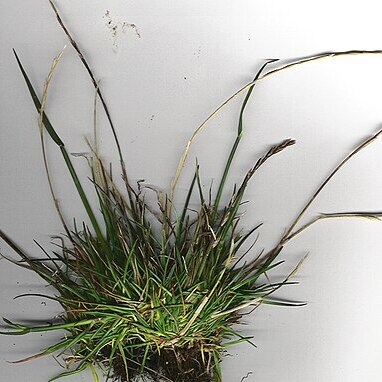Annuals or perennials. Leaf-blades flat or rolled, auriculate. Inflorescence a stiff 2-sided spike, the spikelets alternate in opposite rows with one edge sunk in hollows in the continuous axis. Spikelets 3–12-flowered, the uppermost florets reduced; lower (adaxial) glume suppressed in all except the terminal spikelets and there similar to the upper; upper glume persistent, external, linear to oblong, 5–9-nerved, becoming hardened; lemmas rounded on the back, 5–9-nerved, awnless or with a straight awn from near the tip; palea as long or nearly as long as the lemma. The taxonomy of the genus is confused by the relative ease with which the species will hybridize and introgress. Some of the species will also hybridize freely with certain species of Festuca, and this has sometimes been considered an indication that the two genera should be united.
Annual or perennial. Leaf blades linear, flat or rolled, often auriculate; ligule membranous. Inflorescence a single, stiff, 2-sided raceme, spikelets arranged edgeways on, alternate in 2 opposite rows, their inner edges sunk in hollows of the tough rachis. Spikelets laterally compressed, florets several to many, uppermost florets reduced, disarticulating below each floret; glumes leathery; lower glume suppressed except in terminal spikelet and there similar to upper; upper glume abaxial, narrow, persistent, shorter than lemmas to as long as spikelet; lemmas membranous to leathery, rounded on back, 5–9-veined, with or without a subterminal awn; palea usually equal to lemma. Caryopsis tightly enclosed by hardened lemma and palea; hilum linear.
Spikelets solitary at each node of the spike, several-fld, placed edge-wise to the rachis, the edge fitting into a concavity; disarticulation above the glumes and between the lemmas; first glume none except in the terminal spikelet; second glume (on the side away from the rachis) narrowly lance-oblong, strongly 3–11-veined; lemmas rounded on the back, herbaceous or subcoriaceous, obtuse to acute, awned from the tip or awnless, 3–7-veined, the intermediate veins usually obscure; palea thin; lvs flat, spikes elongate, the summit of each spikelet seldom reaching the base of the next one above it on the same side. 7, temp. Eurasia.
Spikelets sessile, solitary, 3-11-flowered, usually laterally compressed, rarely subcylindrical, awned or muticous; florets hermaphrodite but the uppermost often reduced; rhachilla disarticulating above the glumes and between the florets, glabrous.
Glumes 2 in the uppermost terminal spikelet, 1 (the superior) in the lateral spikelets, persistent, abaxial, 7-9-nerved, linear to oblong, chartaceous to coriaceous, not keeled, with the apex obtuse to acute, awnless.
Lemmas 5-7(-9)-nerved, membranous to chartaceous, dorsally rounded, oblong with the apex subobtuse and usually shortly 2-dentate, glabrous, awnless or awned from near the apex.
Paleas about as long as the corresponding lemmas, 2-keeled, chartaceous-membranous, elliptic or oblong, apex obtuse and often minutely 2-dentate, keels crested or ciliate.
Inflorescence a solitary terminal spike, with the spikelets arranged in 2 ranks on opposite sides of the rhachis and inserted alternatively in depressions edgewise to it.
Caryopsis elliptic-oblong to linear-oblong in outline, dorsally with a longitudinal groove, ventrally sulcate, with a short apical appendage; hilum linear.
Ovary glabrous, obovate-truncate, styles distinct, rather short, plumose for the whole length.
Annuals or perennials of various habitats.
Lodicules 2, minute, ovate-lanceolate.
Ligule a hyaline membrane.

